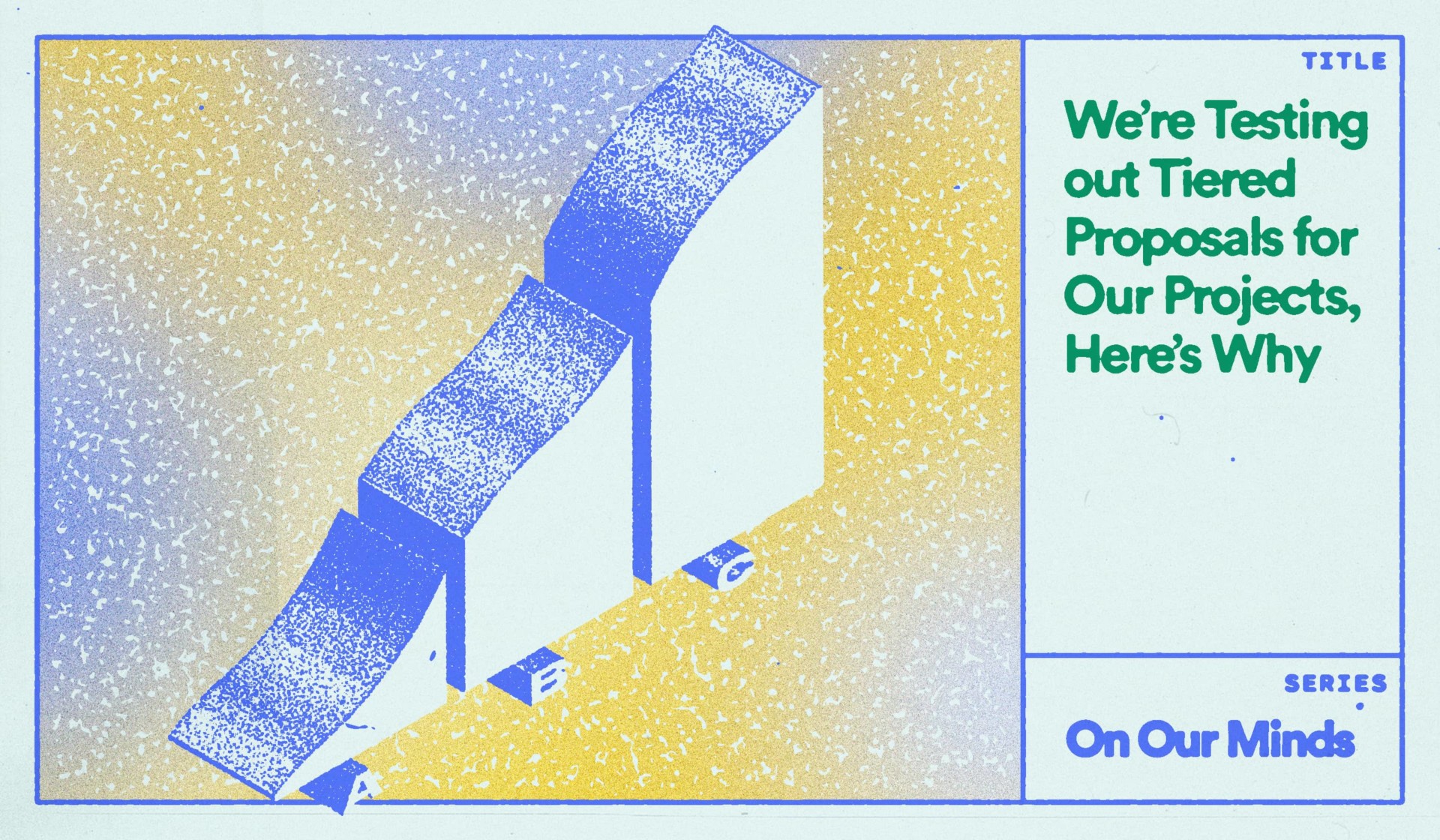The traditional proposal route
As a creative agency, our line of work is pretty simple. We get introduced to a new client or idea, and we get a couple of hours with the client to explore what their idea is and the business problem we’re trying to solve. Then voilà! We pitch what they wanted to hear, which solves their exact business problem. We now have a happy client, and the cycle repeats itself. Right?
Not exactly.
You know that process where you identify you need help, you reach out to potential partners, and you hear all their ideas before picking one to work with? Let’s call that the pitch-decision loop. The pitch-decision loop is designed to make client decisions easier.
As a client, you tell potential vendors what you want over a couple of hours. You wait to hear back on ideas and price points within about two weeks (pitch). Then you evaluate as a team and respond back with a yes or no to all the potential partners (decision).
Boxes are checked.
Stakeholders are happy.
And, hopefully, you have found a great strategic partner—hooray!
Here’s the problem
From our perspective, as a learning partner, those couple of hours with a new client, learning their business, while helpful, aren’t nearly enough. It’s tough to understand years of organizational learning context, align on metrics of success, agree on a features and functionality list, and understand company politics in less time than we spend on Zoom in an average day. Sometimes clients are challenged to answer those questions themselves: “Measure of success? Behavior Change? Platform? We just want a course!”
The problem is that we end up making assumptions about what type of project it’ll be, because we have only so much information and context as someone outside of the organization. Don’t get us wrong, we’ve hired the smartest people we know, and solving learning problems is our expertise—but are we being good partners if our assumptions drive so much of the project outcome?
How can this partnership be better?
This is where the idea for presenting tiered proposals or options came from. We’re starting to ask ourselves, “How might we make the proposal process (partnership) be more valuable for everyone involved?”
From our perspective, good strategy is founded on this principle: strategy is the act of creating options, then making decisions against those options.
So we thought, “How can we get our client involved in the strategy with us?” Presenting options is one of the ideas that brings our clients into the conversation and helps us build a better relationship (partnership) together. Here’s how:
It gets our clients involved early
When clients are involved early, we can work together to examine the pros and cons of multiple approaches, then make the best decision possible.
This approach starts to break down the pitch-decision loop and turn it into a conversation. That’s important. We want the pitch-decision loop to be less of a presentation and more of a conversation. Different clients have different value scales, based on a variety of factors. When you’re starting a business relationship, having a discussion rather than a presentation can be extremely valuable for everyone: This is how we think—how do you think? Do you like how we think? Then check and adjust accordingly. It’s the first feedback loop among many, as more decisions will be made throughout the project.
We also recognize that we don’t have all the answers on our team. Those couple of hours we spent learning about a client’s business can never replace the experience and perspective our clients have. Presenting options allows us to get closer to collaboration, where we’re continually learning from each other to create the best outcome.
It adds more value, faster
Being forced to present options helps us play with constraints and makes our team think more creatively. Presenting options helps us be the partner we want to be.
We don’t want to take what the client wants at face value. We’re interested in having a proactive conversation regarding what it means to solve the problem, similar to how you wouldn’t tell a doctor that you need to amputate your leg because your knee hurts. We try our best to take the symptoms from the client and go beyond the ask. What’s really going on here?
It involves less pressure for everyone (doesn’t that sound nice?)
In the pitch-decision loop, there’s a lot of pressure! As an agency, we have to put together the right solution and pitch perfectly. Presenting multiple options helps take all that pressure off.
As a client, you have to collect those pitches and then make a decision on whose is the best. That’s a lot of time-consuming work. And what if you’re wrong on the decision? Depending on the project, it could have serious consequences. Considering multiple options from a partner helps take that pressure off.
But wait, more choices isn’t always better, right?
Let’s get meta. The strategy of this strategy isn’t without its own flaws. Having more choices isn’t always better. (That’s why this is something we’re still thinking through).
The Paradox of Choice by Barry Schwartz argues that having too many choices leads to anxiety and abandoned shopping carts. Analysis paralysis dictates that too much information can actually slow down and hurt the decision making process. Productivity experts famously wear one style and color of clothing (think Steve Jobs and black turtlenecks) to reduce decision fatigue. And agency dogma believes that if you present multiple options to a client they lose confidence in the agency’s expertise. There’s solutions to each of those problems.
So now what?
It’s time for testing and feedback. Maybe we switch over to tiered proposals entirely, or maybe we find that they’re valuable for certain partnerships and not for others. I’m excited about exploring these options. What do you think?
Want to learn more about what it’s like to partner with our team?
Check out our multi-year project with Royal Caribbean.
Read the case study→